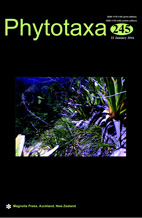Abstract
Thalassiosira constricta was first described from Tromsø in the Norwegian Sea. The species was placed in the large and morphologically diverse genus Thalassiosira based on the presence of classical features of that genus, including the formation of chains held together by β-chitin threads extruded from central fultoportulae. We recently discovered T. constricta in Korean coastal waters near Sinsi Island. Detailed morphological analyses revealed the following cell wall features: i) cells arranged in chains, with adjacent cells directly abutting one another or distinctly separated and linked by β-chitin threads extruded from a central cluster of 0–14 fultoportulae, ii) delicate, biseriate poroid areolae along radial ribs on the valve face and coarse loculate areolae on the valve mantle, iii) a cingulum structure consisting of finely perforated valvocoupla and copula and scratched pleurae, iv) distinct antiligula on the valve, v) a single ring of marginal fultoportulae, vi) one rimoportula located within the ring of marginal fultoportulae, vii) fultoportulae with internal extensions that lack opercula, and viii) fultoportulate with four fully exposed satellite pores, each in a depression and surrounded by a defined cowling. Phylogenetic analysis of nuclear and plastid markers revealed a sister relationship with Bacterosira bathyomphala. Based on these findings, we transfer T. constricta to Bacterosira as Bacterosira constricta comb. nov. and offer an emended the description of the genus Bacterosira, which appears to be one of only a few monophyletic marine genera in Thalassiosirales.

